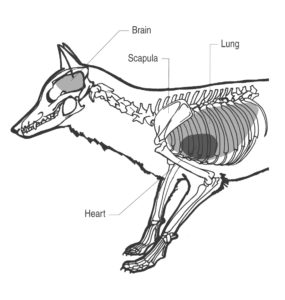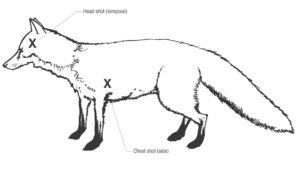Endorsed by the Invasive Plants and Animals Committee 2016 with minor updates September 2017.
DOWNLOAD AS PRINTABLE PDF
Background
The introduced European red fox (Vulpes vulpes) has a significant impact on native fauna and agricultural production. Fox control methods include lethal baiting, trapping, shooting, den fumigation, den destruction and exclusion fencing.
Trapping of foxes is undertaken in areas where poison baiting is unacceptable and other methods cannot be used e.g. semi-rural and urban/residential areas. Trapping may be useful for the control of nuisance animals but is not effective as a general fox control method. In urban/residential areas, cage traps are preferred over leg hold traps as fewer injuries are sustained, non-target animals can be released unharmed and trapped foxes can be transported away from the area for euthanasia. Refer to Trapping of foxes using cage traps. Leg-hold, padded-jaw traps should only be used at sites where the animal can be killed by shooting whilst still held in the trap.
This National Standard Operating Procedure (NATSOP) is a guide only; it does not replace or override the legislation that applies in the relevant state or territory jurisdiction. The NATSOP should only be used subject to the applicable legal requirements (including OH&S) operating in the relevant jurisdiction.
Application
- Trapping is time-consuming and labour intensive and is therefore an inefficient method for large-scale fox control in Australia.
- Traps have the potential to cause significant suffering and distress so should only be used when there is no suitable alternative.
- Humane and successful trapping requires extensive training and experience. Trapping by inexperienced operators can result in ‘trap-shy’ foxes that are difficult to catch because they have previously escaped from a carelessly prepared and presented trap.
- Selection of appropriate traps and trap sites will minimise the damage, pain and distress caused to target and non-target animals.
- Every effort must be made to avoid animal deaths from factors such as exposure, shock, capture myopathy and predation.
- Once trapped, foxes are euthanased by shooting at the site of capture.
- Traps must be used in accordance with relevant state and territory legislation (see Box 1). In some states, for example Western Australia, a permit may be required to trap within certain municipalities.
- Shooting of foxes should only be performed by skilled operators who have the necessary experience with firearms and who hold the appropriate licences and accreditation. Storage and transportation of firearms and ammunition must comply with relevant legislation requirements.
Animal welfare considerations
Impact on target animals
- Leg-hold traps cause pain and distress in two ways: pressure of the trap jaws on the captured limb and restraint of the animal. Injuries will inevitably occur to some animals, especially when they struggle to escape the trap. These range from swelling of the foot and lacerations to dislocations and fractures. Foxes may also inflict injuries to their feet and legs by chewing on the captured limb, and to their teeth, lips and gums by chewing at the trap jaws. To reduce capture distress, trapped foxes must be destroyed as quickly and humanely as possible.
- Traps must be inspected daily to prevent prolonged suffering from exposure, thirst, starvation and/or shock.
- It is preferable to set up traps at sites where vegetation can provide shade and shelter. However, sites should be avoided where there is a risk of the trapped animal becoming entangled in understorey vegetation or fences, which could result in dislocation of the limb.
- Where possible, trapping should be avoided when adverse weather conditions threaten the welfare of trapped animals.
- Captured animals must be approached carefully and quietly to reduce panic, further stress and risk of injury.
- To minimise the animal welfare implications of orphaning dependant cubs, it is preferable not to undertake trapping when vixens are lactating (ie August/September).
- If lactating vixens are shot, reasonable efforts should be made to find dependent cubs and kill them quickly and humanely by either shooting (with a single shot to the brain) or by fumigation of the den with carbon monoxide (refer to Fumigation of fox dens with carbon monoxide).
Impact on non-target animals
- Traps are not target specific, so a wide range of non-target species may be caught. These can include birds (eg ravens, magpies, pied currawongs), kangaroos, wallabies, rabbits, hares, echidnas, goannas, wombats, possums, bandicoots, quolls and sheep.
- Different groups of non-target animals suffer different levels of injury and distress. For example:
– wallabies often experience serious injuries (eg dislocations), due to the morphology of their limbs and because they become very agitated when restrained.
– goannas (eg lace monitors) also suffer from dislocations and can die from hyperthermia.
– birds, rabbits and hares can be preyed upon by foxes, cats and wild dogs whilst caught in traps.
- Traps must not be set near areas such as waterholes or gully crossings that are regularly frequented by non-target species.
- Live non-target animals caught in traps must be examined for injuries and signs of illness or distress and dealt with as follows:
– animals which are unharmed or have only received minimal injuries such as minor cuts or abrasions should be immediately released at the site of capture.
– animals which have more severe injuries or which are suffering from thermal stress should receive appropriate attention. An animal suffering from thermal stress can initially be placed in a suitable quiet holding area which provides warmth or shade to allow recovery before release. Animals with treatable injuries that cannot be immediately released or those failing to recover from thermal stress should be presented to a veterinarian or a registered wildlife carer for treatment.
– animals that have injuries which are untreatable or which would compromise their survival in the wild should be euthanased using a technique that is suitable for the species. For more information on euthanasia techniques refer to Methods of euthanasia.
- If a dog or a cat is caught in the trap, it should be taken to the nearest council pound for assessment. In some States this is a legal requirement.
Health and safety considerations
- Firearms are hazardous. All people should stand well behind the shooter when an animal is being shot. The line of fire must be chosen to prevent accidents or injury from stray bullets or ricochets.
- Care must be taken when handling fox carcasses as they may carry diseases such as hydatidosis and sarcoptic mange that can affect humans and other animals. A fox with obvious mange should only be handled while wearing gloves. Routinely wash hands after handling all fox carcasses.
- Operators should be wary of the risks of injury when placing and setting traps. Protective clothing, boots and leather gloves may help prevent injuries from shovels, hammers and trap jaws.
Equipment required
Traps
- Approved padded-jaw traps suitable for catching foxes must be used for example, Victor Soft-Catch trap no.1½ or no.3. It is illegal to use serrated, steel-jawed traps in most states and they are not recommended for use in any circumstances on animal welfare grounds.
- Traps must have the following characteristics:
– the jaws have no teeth.
– the jaws are offset to increase the space between them when closed (ie a distance of 6—8 mm remains when the jaws are closed).
– each jaw has a rubber-like pad to cushion the impact of the jaws on the limb and to prevent the limb sliding out. The padding fills the offset gap when the jaws are closed.
- Traps should also have:
– a spring placed in the anchor chain to act as a shock absorber, reducing the chance of dislocation of the captured limb. Swivels should be located on both ends of the anchor chain to allow the trap to twist as the animal struggles to escape.
– adjustable pan tension so that an appropriate force is required to depress the pan and trigger the trap. This minimises the chance of non-target animals setting off the trap.
Lures
- Olfactory stimuli such as fox faeces and/or urine or a commercially prepared lure (eg synthetic fermented egg may be used to lure foxes into the trap set).
- The attractiveness of lures will vary with season and location.
Meat baits
- A handful of meat bait is placed near the trap. Beef heart, liver rabbit, lamb, chicken, and kangaroo have all been used as bait. The bait can be covered with a light dusting of soil to reduce foraging by corvids and to mimic food cached by a fox.
- Attractiveness and palatability of the bait will vary with season and location.
Firearms and ammunition
- Firearms no smaller than a .17 calibre rimfire with hollow/soft point ammunition are recommended for euthanasia.
- 12 gauge shotguns with shot sizes of BB or AAA may also be used.
- The accuracy and precision of firearms should be tested against inanimate targets prior to the commencement of any shooting operation.
Procedures
Selection of trap sites
- Traps should be set along tracks and trails or other areas frequented by foxes for example, scent pads, scratch points and around carcasses. Do not set traps near fences and other objects such as trees, bushes etc. in which the trapped fox may become entangled.
- The location of all trap sites must be accurately recorded and marked. This information should be readily available to others in case the trapper is unable to return to check traps.
Placing and setting the trap
- It is preferable to set traps at the end of each day and check early each morning. If traps are left set during the day, they should be checked again in late afternoon.
- Before setting each trap ensure that it is functioning properly.
- Traps should only be anchored to stakes or fixed objects if there is a shock absorbing device such as a spring fitted to the anchor chain and a swivel attaching the chain to the trap. It is recommended to use a short length of chain (approx 50 cm). Alternatively, the trap can be tied to ‘drags’, objects such as rocks, solid pieces of steel or small logs that will move when the fox pulls against the trap.
- Set the trap and place into position in the hole in the ground. Ensure that surrounding shrubs or debris will not interfere with the spring mechanism.
- Carefully camouflage the area around the trap with leaves, grass debris etc. but leave a slightly cleared area (10—15 cm) over the area of the plate.
- Place the meat bait and/or lure a suitable distance away so that the fox is likely to step on the trap to smell it for example, on a slightly elevated clump of grass, stick or rock behind the trap.
Shooting of foxes
- Trapped live foxes should be euthanased by shooting whilst still held by the trap.
- Unnecessary people should keep away from the area to allow the fox to become less agitated. The shooter should approach the animal in a calm and quiet manner.
- To maximise the impact of the shot and to minimise the risk of misdirection the range should be as short as possible that is, 5—20 cm from the head if using a rifle, 1—2 m if using a shotgun.
- Never fire when the fox is moving its head, be patient and wait until the fox is motionless before shooting. Accuracy is important to achieve a humane death. One shot should ensure instantaneous loss of consciousness and rapid death without resumption of consciousness.
- Shots must be aimed to destroy the major centres at the back of the brain near the spinal cord. This can be achieved by one of the following methods (see Diagram 1):
Frontal position (front view)
The firearm is aimed at a point midway between the level of the eyes and the base of the ears, but slightly off to one side so as to miss the bony ridge that runs down the middle of the skull. The aim should be slightly across the centreline of the skull and towards the spine.
Temporal position (side view)
The firearm is aimed horizontally at the side of the head at a point midway between the eye and the base of the ear.
- Death of shot animals should always be confirmed by observing the following:
– Absence of rhythmic, respiratory movements
– Absence of eye protection reflex (corneal reflex) or ‘blink’
– A fixed, glazed expression in the eyes
– Loss of colour in mucous membranes (become mottled and pale without refill after pressure is applied).
If death cannot be verified, a second shot to the head should be taken immediately.

Head shot (frontal)

Side view (skeleton)

Recommended shot placements for foxes Note: Head shots (temporal or frontal) should be used for shooting foxes caught in traps.
References
- Boggess EK (1990). Traps, trapping and furbearer management: A review. The Wildlife Society Technical Review Vol 90, Iss 1. 31pp.
- Fleming, PJS, Allen LR, Berghout MJ, Meek PD, Pavlov PM, Stevens P, Strong K, Thompson JA and Thomson PC (1998). The performance of wild-canid traps in Australia: efficiency, selectivity and trap-related injuries. Wildlife Research 25:327-338.
- IAFWA (2003). Best Management Practices for Trapping Coyotes in the Eastern United States. International Association of Fish and Wildlife Agencies.
- Kreeger TJ, White PJ, Seal US and Tester JR (1990). Pathological responses of red foxes to foothold traps. Journal of Wildlife Management 54:147-160.
- Longair JA, Finley GG, Laniel MA, MacKay C, Mould K, Olfert ED, Roswell H and Preston A (1991). Guidelines for euthanasia of domestic animals by firearms. Canadian Veterinary Journal 32:724-726.
- Meek PD, Jenkins DJ, Morris B, Ardler AJ and Hawksby RJ (1995). Use of two humane leg-hold traps for catching pest species. Wildlife Research 22:733-739.
- Saunders G, Coman B, Kinnear J and Braysher M (1995). Managing vertebrate pests: foxes. Australian Government Publishing Service, Canberra.
- UFAW (1988). Humane killing of animals (4th Ed). Universities Federation for Animal Welfare, Potters Bar, England.
The Centre for Invasive Species Solutions manages these documents on behalf of the Environment and Invasives Committee (EIC). The authors of these documents have taken care to validate the accuracy of the information at the time of writing. This information has been prepared with care but it is provided “as is”, without warranty of any kind, to the extent permitted by law.
Connect with government
It is important to contact the relevant federal, state or territory government agency before undertaking fox control to ensure you have the right permits in place
Connect













